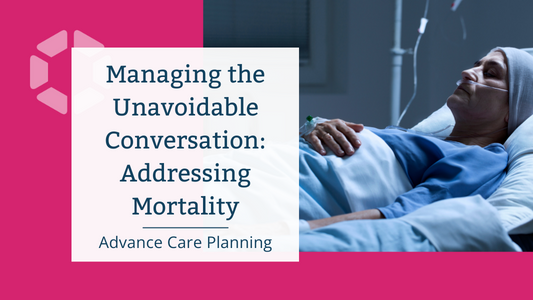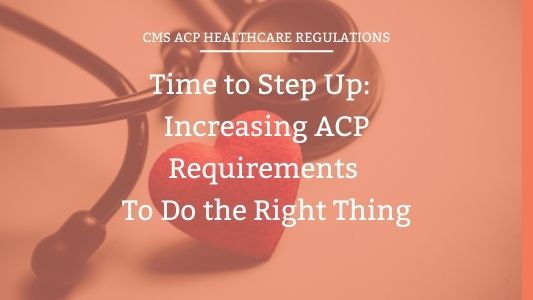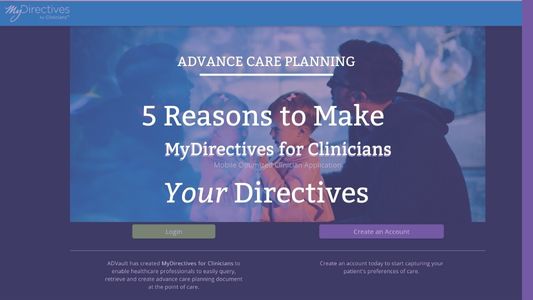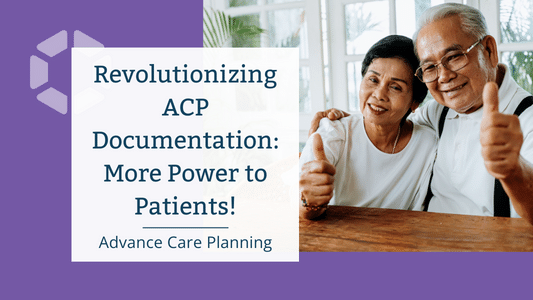
Part One of Our Six-part Series: Confronting Advance Care Planning Misconceptions
Welcome to what may be for all too many an eye-opening series about healthcare stakeholder advance care planning (ACP) misconceptions.
Our aim? To address head-on the issues and opinions raised around the efficacy of ACP in articles such as the highly debated October 2021 piece on What’s Wrong with Advance Care Planning?
In this series, we’ll evaluate alleged advance care planning failures, scrutinize suggested improvements, and provide actionable steps you can take to measurably impact ACP's effectiveness in your organization. Each post will light a path to a more patient-centric ACP approach.
First, we tackle the most daunting barrier – normalizing advance care planning conversations to help patients, residents, and members address their mortality.
Death and mortality. The subject most of us shudder to confront.
We all know discussions of one’s mortality are incredibly emotional and challenging when grappling with severe illnesses, debilitating pain, or impairment. Adding an “end-of-life” discussion adds to the complexity. In these situations, healthcare professionals are tasked to help manage hopes and fears while considering factors such as comfort, financial control, sustenance, social connections, familial and social roles, and spiritual commitments.
While these discussions may be complicated and intensely personal, they can also be immensely beneficial in identifying the often unspoken and unique goals of those in our care. Unfortunately, our current approach to measuring quality healthcare often undervalues an individual’s voice, leading to a disconnect in patient-centered care delivery. This University of Michigan Health and Retirement Study reveals a startling statistic that drives this point home.
“70% of participants aged 60 and older at death, who faced treatment decisions in their final days, were incapable of participating in these decisions.”
According to the 2016 study, 70% of participants aged 60 and older at death, who faced treatment decisions in their final days, were incapable of participating in these decisions. This statistic alone underlines the urgent necessity to reform our approach to ACP by making these conversations a regular part of patient, resident, and member interactions.
Everyone is hesitant to make decisions in advance.
The ACP landscape is riddled with misconceptions and a general lack of awareness that impacts the true value for ALL stakeholders as described below.
Patient, Member, and Resident
Many harbor the belief that engaging in ACP discussions is synonymous with a death sentence, and fear that completing ACP will lock them into an irrevocable decision. Just the perceived enormity of the process is intimidating, leaving individuals feeling overwhelmed by the prospect of having to account for all possible future medical scenarios. What’s more, the complex, confusing, and jargon-filled nature of the documentation process for living wills, power of attorneys, 'do not resuscitate' orders (DNRs), and advance care planning only adds to their bewilderment.
Physicians
Even those in specializations like oncology who routinely confront the reality of mortality are often reluctant to bring up ACP with their patients. The process is perceived as uncomfortable, time-consuming, and fraught with turmoil and fear. In fact, a 2016 survey shed light on the shocking reality that 68% of physicians had received no training in end-of-life conversations. This lack of training underscores why physicians may be hesitant to navigate these complex conversations.
Hospital and Healthcare Systems
For large healthcare organizations, ACP, or the lack thereof, becomes a focal point when it begins to impact care delivery and readmissions rise. Problems occur when patient wishes are either not documented or inaccessible when they are needed most. This leaves both healthcare providers and loved ones guessing, which causes needless stress.
Healthcare Payers
Unfortunately, payers are often the ones left shouldering the financial burden of unwanted and unnecessary treatments and procedures that do not enhance the value of care, leaving families, friends, and care givers dissatisfied with the care provided. Additionally, payers are cautious to avoid any lingering stigma of the “death panels” misnomer so payers may shy away from open discussions around mortality and ACP.
Normalize ACP at every stage of care.
ACP discussions are not, and never should be, exclusive to certain demographics or conditions. They are, in fact, vital conversations that should be held according to the patient's prognosis. Current CMS regulations stipulate that ACP should be offered to individuals aged 65 and over with two or more chronic conditions and those more than 80 years of age. However, access to ACP varies among patient populations and is especially low among minority groups, a gap that needs urgent attention. Opportunity and access are key to normalizing the ACP conversation.
As recommended by the 2016 Aspen Institute Health Strategy Group report on Improving Care at the End of Life, our approach to ACP should be normalized. We further believe it should be stratified based on the patient's prognosis as described in 2021 article on ACP for Hospitalized Older Adults. For example, the different planning stages may include:
- Regular Care: Here, ACP is introduced as part of annual wellness visits, with an emphasis on naming a healthcare surrogate at the very least.
- Future Care: This step involves patient-centered planning focusing on understanding wellbeing, health, and illness in the coming years. For the 80% of these patients recently admitted to the hospital with a prognosis exceeding a year, future care planning is a good starting point.
- Urgent Care: The focus here is on immediate medical care options, including treatment limitations, illness trajectory, and cardio-pulmonary resuscitation decisions. Patients with a prognosis of less than 12 months should definitely engage in urgent care planning discussions.
- End-of-Life Care: This phase concentrates on providing patient-centered terminal care and determining patient wishes, the place of death, and supportive care options. End-of-Life planning is most beneficial to patients with a prognosis of six months or less.
Dawn of the ACP Revolution: Embracing Technological Advances.
In the digital age, it is only logical to leverage technology to streamline complex processes. Now, electronic health record systems can store and make accessible documentation of a person's medical goals, treatment priorities, and care preferences. A best practice advance care planning software solution such as MyDirectives for Clinicians™ (MyDC), already offers a host of features and functionalities that do just that including:
- Dynamic forms that allow consumers and clinicians to answer a series of intuitive questions that follow a natural conversation flow to help patients, residents, and members articulate their goals of care.
- Flexible digital ACP and portable medical order (PMO) form documentation that allows individuals to update their decisions when needed to reflect changing medical circumstances and quality of life preferences, as opposed to static paper documents.
- Document storage in a HITRUST r2-certified cloud database that protects patient-sensitive data and ensures seamless, interoperable data exchange across the entire healthcare ecosystem, 24/7/365.
By making ACP a regular part of healthcare provision, we not only provide holistic care to those we serve but also pave the way for a healthcare system that is patient-centric, cost-effective, and high in quality. Embracing technological solutions can help everyone navigate this challenging yet essential part of healthcare provision, leading to improved outcomes and an enhanced patient, resident, and member experience.
An opportunity to redefine advance care planning as we know it.
Yes, our current approach to Advance Care Planning may be riddled with misconceptions, fears, and systemic challenges, but that’s all the more reason to address these issues head-on. Innovation leaders are taking the opportunity to implement solutions like MyDC and MyDirectives® to help make difficult mortality conversations simpler, easier, and more comfortable and commonplace than ever.
We say that it’s time to shift our approach toward ACP, and give a voice to patients, honoring their values and ultimately deliver a standard of care that truly caters to the patient's unique needs and desires. With the stakes this high, there's no room for complacency. It's time to take a stand, challenge the status quo, and lead the digital revolution in advance care planning.
Next in our six-part series – The Crucial Role of Healthcare Agents in Advance Care Planning – we’ll discuss the significant importance of selecting and preparing the right surrogate for their role as a trusted healthcare advocate.
Let’s get started on digital ACP together
Secure, Interoperable, Accessible.
MyDirectives offers the only digital advance care planning (ACP) tools and interoperable cloud-based storage that is HITRUST Risk-Based 2-year Certified.






